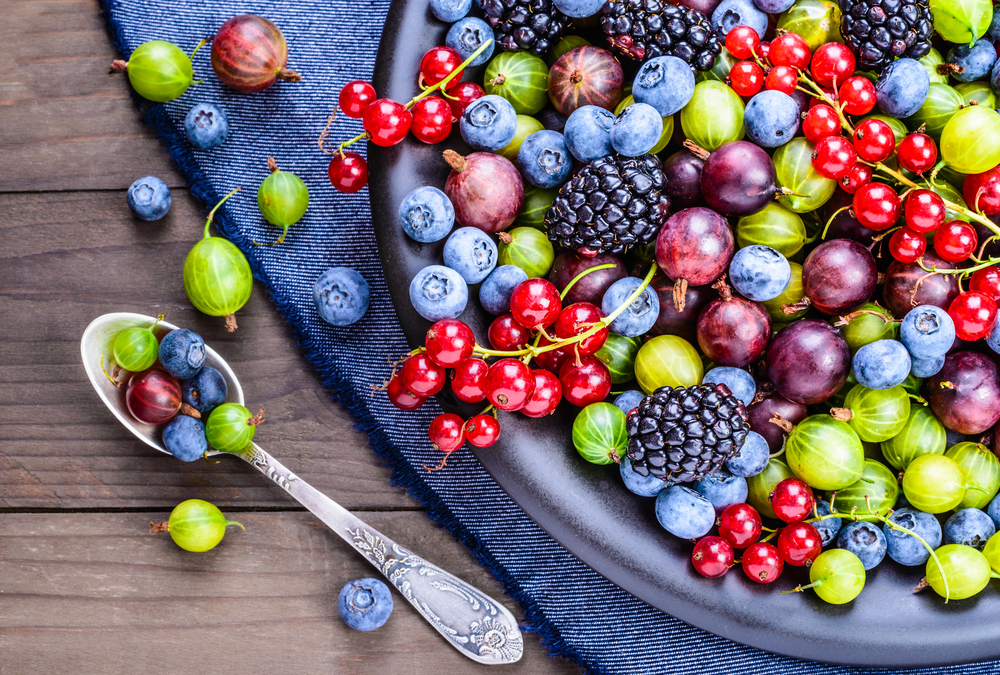By: Lara Shapiro
All of us has both antioxidants and free radicals inside of our bodies at all times. But — when antioxidant levels in the body are lower than that of free radicals because of poor nutrition, toxin exposure, or other factors — oxidation can cause faster aging, damaged cells, and an overworked immune system.
Although there are many antioxidant dietary supplements on the market, health experts typically recommend getting them the old-fashioned way: through high antioxidant foods. Wondering where to find the most antioxidants? We found our top 10 TLS-approved high antioxidant foods that you need in your diet!
What are antioxidants?
Antioxidants are elements, enzymes, or other organic substances that counteract the damage caused by free radicals.
What are free radicals?
To understand the interaction between antioxidants and free radicals, we must first have a general grasp on basic biology and chemistry. Thinking back to middle school: cells are composed of many types of molecules. Molecules consist of one or more atoms of one or more elements joined by chemical bonds. For example, the element oxygen, in its natural state, consists of two oxygen molecules bonded together (O2), and water, a molecule, consists of two hydrogen atoms and one oxygen atom bonded together (H2O). You can probably recall that atoms are made up of a nucleus, protons, neutrons, and electrons. Electrons move about the inner and outer shells of an atom, and are responsible for the bonding of one or more atoms, and therefore determine an atom’s chemical behavior. When an atom’s outer shell of electrons is full, it tends to not react with other surrounding atoms or molecules. However, when the outer shell is not full, the laws of nature leave that atom in search of another electron to balance its charge, by either gaining or losing an electron to either fill or empty its outer shell, or by sharing its electrons by bonding with other atoms to complete its outer shell. An atom or molecule containing these unpaired electrons, making it highly reactive, is what we call a free radical.
How are free radicals formed?
Free radicals can be formed when weak bonds between two atoms or molecules break. Many free radicals are a natural byproduct of our body’s metabolisms, and sometimes the body’s immune system induces the production of free radicals in an effort to neutralize harmful viruses and bacteria. Other sources of free radicals include exposure to radiation, exposure to environmental pollutants, medication, alcohol, tobacco smoke, metals, pesticides, and more.
Why are free radicals harmful?
When a free radical is on the move in search of an electron to fill its outer shell to become more stable, it will attack the nearest molecule and steal one if its electrons. The molecule that has just been robbed is now lacking an electron on its outer shell, therefore becoming an unstable, free radical itself, and ultimately causing a chain reaction. If this chain reaction continues long enough, it can lead to the disruption of a living cell. The human body should be able to manage free radicals. However, if antioxidants are unavailable, or if free radical production becomes excessive, damage can occur. If free radicals overwhelm the body’s ability to regulate them, a condition known as oxidative stress begins. Oxidative stress adversely alters lipids, proteins, and nucleic acids (DNA, RNA), and are associated with diseases such as cancer, atherosclerosis, Alzheimer’s disease, Parkinson’s disease, and others. The scary part – symptoms of oxidative stress often times go unnoticed.
How can I prevent free radicals in my body?
Antioxidants keep free radicals in check. They are substances that will inhibit the oxidation of other compounds. Antioxidants are molecules that are stable enough to donate an electron to free radicals, therefore stabilizing the free radical and halting it’s “attack” on other molecules. Reduce oxidative stress by consuming foods or supplements that contain antioxidants.
Top 10 High Antioxidant Foods
1. Red Berries
Red berries – especially raspberries and strawberries – contain a substance called ellagic acid, a phytochemical that may help protect against cancer-causing agents in one’s diet and in the environment.
2. Dark Green Veggies
Dark green veggies are a great source of magnesium and potassium. Vegetables such as broccoli, spinach, kale, and collard greens are high in nutrients that fight disease: vitamins C, E, and A, and calcium. Vitamin C is sometimes nicknamed the “grandfather” of traditional antioxidants, as it acts as a major electron donor, maintains optimal electron flow in your cells, and protects proteins, lipids, and other vital elements in your body. Many dark green vegetables contain antioxidant phytochemicals, one being kaempferol, which may help dilate blood vessels and may have cancer-fighting properties. Leeks, lettuce, and kale also contain strong antioxidants known as lutein and quercetin.
3. Beans
Green beans and soybeans are a good source of Vitamin C, calcium, and selenium. Black beans and kidney beans are a great source of folate (Vitamin B9), and lentil beans and black-eyed peas are a great source of both folate and zinc. Folate and zinc have antioxidant properties that counteract reactive oxygen species (free radicals).
4. Purple, Red & Blue Grapes
Grapes – especially dark-colored grapes – are packed with phytochemicals, which are antioxidants that may help protect against cancer and heart disease. Grapes contain two phytochemicals, anthocyanin and proanthocyanin, which may be especially good for the immune system. On top of containing antioxidants, grapes also contain Vitamin C and selenium.
5. Nuts
Nuts contain what we call “healthy” fats, and smaller amounts of protein and carbohydrates. Each nut has a unique array of minerals, phytochemicals, and types of fat, and most nuts contain phytochemicals such as resveratrol (sometimes referred to as the “fountain of youth” for its ability to steer away age-related diseases) and plant sterols. Walnuts have the highest Omega III content of plants; brazil nuts are a great source of selenium.
6. Fish
Fish are full of powerful omega III fatty acids, which may help prevent inflammatory diseases. Fish are also a good source of Vitamin D, which can be tricky to find in foods. Sardines, oysters, tuna steak, shark steak, herring, salmon, mackerel, wild rainbow trout, and albacore tuna are the fish to put in your dish!
7. Sweet Potatoes & Orange Vegetables
Both white and sweet potatoes provide key nutrients such as vitamins C and B6, fiber, and potassium, although sweet potatoes have more – sweet, right? Sweet potatoes also provide calcium and a mighty portion of vitamin A. Orange vegetables are also your phytochemical allies; carrots and are also a good source of vitamin A, and butternut squash and acorn squash are great for both vitamin A and C.
8. Blueberries
Recent studies have suggested that blueberries may help protect cells from damage, and also reduce inflammation. They contain many vitamins and minerals that are well-known for supporting the immune system, as well as phytochemicals which may help protect against cancer and heart disease.
9. Whole Grains
Some research has shown that people who eat at least one serving of whole grains a day, and having a lower risk of heart disease and stroke. Whole grains provide selenium, zinc, and phytochemicals that may help protect against heart disease and cancer. Add more whole grains to your diet by eating whole grain bread instead of white bread, corn tortillas instead of flour tortillas, and brown or wild grain rice instead of white.
10. Tea
Tea contains two potent phytochemicals: anthocyanin and proanthocyanin, both of which are antioxidants that help combat inflammation. As well as the phytochemicals, tea contains catechins, which are antioxidants that are thought to block cell damage that can lead to cancer. Green tea in particular contains many other protective phytochemicals. The catechin epigallocatechin gallate (EGCG) is an especially potent antioxidant, high doses of which are found in green tea. If caffeinated drinks aren’t quite your cup of tea, try decaf teas which will also contain these phytochemicals!
The high antioxidant foods don’t stop there, however. Other high delicious antioxidant foods include artichokes, goji berries, red cabbage, and even dark chocolate. Surprisingly enough, dark chocolate has up to 15mmol of antioxidants per 3.5 ounces (100 grams). That’s even more than blueberries and raspberries, which contain up to 9.2 and 2.3mmol of antioxidants in the same serving size! However, keep in mind other nutrition factors, and don’t limit your antioxidant source to just this one sweet treat.
While your body naturally produces antioxidants, give it the extra nudge and indulge in these top 10 TLS-approved high antioxidand foods to strengthen your shield against heart disease, cancers, and more!
Resources:
http://www.healthchecksystems.com/antioxid.htm
https://www.ncbi.nlm.nih.gov/pmc/articles/PMC4310837/
https://www.livescience.com/54901-free-radicals.html
https://www.news-medical.net/health/What-is-Oxidative-Stress.aspx
https://www.ncbi.nlm.nih.gov/pmc/articles/PMC3249911/
https://www.healthline.com/nutrition/foods-high-in-antioxidants#section13




Comments (1)